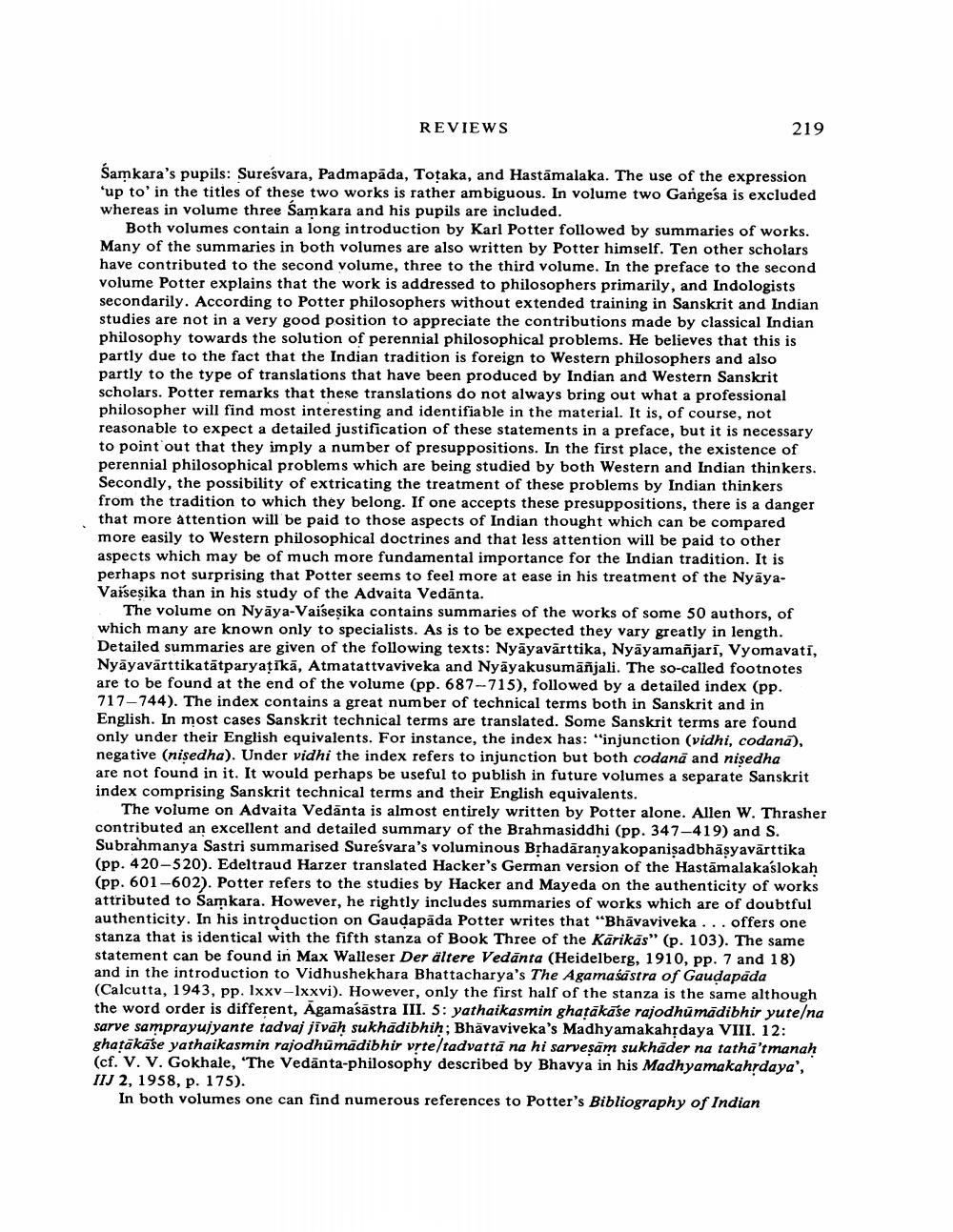Book Title: Book Reviews Author(s): J W De Jong Publisher: J W De Jong View full book textPage 3
________________ REVIEWS 219 Samkara's pupils: Suresvara, Padmapada, Totaka, and Hastāmalaka. The use of the expression *up to' in the titles of these two works is rather ambiguous. In volume two Gangesa is excluded whereas in volume three Samkara and his pupils are included. Both volumes contain a long introduction by Karl Potter followed by summaries of works. Many of the summaries in both volumes are also written by Potter himself. Ten other scholars have contributed to the second volume, three to the third volume. In the preface to the second volume Potter explains that the work is addressed to philosophers primarily, and Indologists secondarily. According to Potter philosophers without extended training in Sanskrit and Indian studies are not in a very good position to appreciate the contributions made by classical Indian philosophy towards the solution of perennial philosophical problems. He believes that this is partly due to the fact that the Indian tradition is foreign to Western philosophers and also partly to the type of translations that have been produced by Indian and Western Sanskrit scholars. Potter remarks that these translations do not always bring out what a professional philosopher will find most interesting and identifiable in the material. It is, of course, not reasonable to expect a detailed justification of these statements in a preface, but it is necessary to point out that they imply a number of presuppositions. In the first place, the existence of perennial philosophical problems which are being studied by both Western and Indian thinkers. Secondly, the possibility of extricating the treatment of these problems by Indian thinkers from the tradition to which they belong. If one accepts these presuppositions, there is a danger that more attention will be paid to those aspects of Indian thought which can be compared more easily to Western philosophical doctrines and that less attention will be paid to other aspects which may be of much more fundamental importance for the Indian tradition. It is perhaps not surprising that Potter seems to feel more at ease in his treatment of the NyāyaVarseșika than in his study of the Advaita Vedānta. The volume on Nyāya-Vaiseșika contains summaries of the works of some 50 authors, of which many are known only to specialists. As is to be expected they vary greatly in length. Detailed summaries are given of the following texts: Nyāyavärttika, Nyāyamañjari, Vyomavati, Nyāyavärttikatātparyaţikā, Atmatattvaviveka and Nyāyakusumāñjali. The so-called footnotes are to be found at the end of the volume (pp. 687-715), followed by a detailed index (pp. 717-744). The index contains a great number of technical terms both in Sanskrit and in English. In most cases Sanskrit technical terms are translated. Some Sanskrit terms are found only under their English equivalents. For instance, the index has: "injunction (vidhi, codana), negative (nisedha). Under vidhi the index refers to injunction but both codanā and nisedha are not found in it. It would perhaps be useful to publish in future volumes a separate Sanskrit index comprising Sanskrit technical terms and their English equivalents. The volume on Advaita Vedanta is almost entirely written by Potter alone. Allen W. Thrasher contributed an excellent and detailed summary of the Brahmasiddhi (pp. 347-419) and S. Subrahmanya Sastri summarised Sureśvara's voluminous Bịhadaranyakopanişadbhäşyavārttika (pp. 420-520). Edeltraud Harzer translated Hacker's German version of the Hastāmalakaslokah (pp. 601-602). Potter refers to the studies by Hacker and Mayeda on the authenticity of works attributed to Samkara. However, he rightly includes summaries of works which are of doubtful authenticity. In his introduction on Gaudapāda Potter writes that “Bhāvaviveka. . . offers one stanza that is identical with the fifth stanza of Book Three of the Karikās" (p. 103). The same statement can be found in Max Walleser Der ältere Vedānta (Heidelberg, 1910, pp. 7 and 18) and in the introduction to Vidhushekhara Bhattacharya's The Agamasastra of Gaudapada (Calcutta, 1943, pp. Ixxv-lxxvi). However, only the first half of the stanza is the same although the word order is different, Agamaśāstra III. 5: yathaikasmin ghatākāse rajodhümădibhir yute/na sarve samprayujyante tadvaj jivāḥ sukhadibhiḥ; Bhāvaviveka's Madhyamakahțdaya VIII. 12: ghatākase yathaikasmin rajodhūmadibhir vrte/tadvatta na hi sarvesam sukhāder na tathā'tmanah (cf. V. V. Gokhale, 'The Vedānta-philosophy described by Bhavya in his Madhyamakahrdaya', IIJ 2, 1958, p. 175). In both volumes one can find numerous references to Potter's Bibliography of IndianPage Navigation
1 2 3 4 5 6 7 8 9 10 11 12 13 14 15 16 17 18
